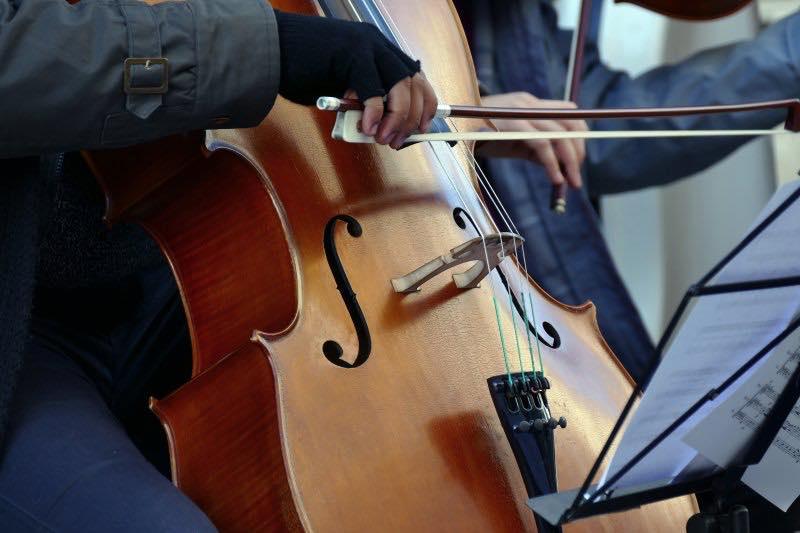Tuning your cello correctly is one of the most important skills you will learn in early lessons. Learning the cello tuning notes and the correct methods for different rehearsal and performance settings will set you apart. Good intonation can be the deciding factor between an excellent performance and a disastrous one, but if your strings aren’t in tune then it is sure to be a disaster.
Today, we will discuss the right way to tune your cello in different settings, and the different versions of cello tuning used by professionals.
Tuning By Ear Vs. Tuning With a Tuner
You can decide to tune with or without a tuner or tuner app. Whether you use an app or not, you will start by tuning the A string. The standard tuning for A is 440 Hz, but the cello tuning note for the first string is one octave below the reference.
When you tune with a device, it measures the frequency of the open string and compares it to a reference pitch automatically. This way, you only have to raise or lower the cello string according to the device to tune your instrument.
Without a tuner you can tune with a reference pitch and good ear training practice. My students start with a tuner at home, but I help them practice ear training during lessons so they can learn to tune without one.
Most professionals don’t use a tuning app because they have practiced tuning and ear training so they only require a reference note. But there is no shame in using a digital tuner, especially as a student cellist. There are even professional orchestral musicians who use a digital tuner before going on stage, so they only need to make small adjustments to their open strings to match the orchestra.
If you want to play in a professional orchestra or chamber group, you must learn to tune to a reference pitch. This is because in these settings there are certain traditions around tuning which you will pick up as a classical musician.
Tuning Your Cello in an Orchestra Setting
If you have been to a professional orchestra concert you probably remember how it started: the oboist plays and holds an A while the orchestra tunes in groups (woodwinds, brass and percussion, then strings).
The oboist tuning the orchestra usually uses a digital tuner to make sure their note is perfect. This tuner can be set to 440 Hz, but sometimes oboists set it to 441 or 442 Hz. As mentioned earlier, the reference pitch from the oboe is an octave above the cello tuning note, so we tune one octave below what we hear. After the given note you must tune the rest of your strings quietly, so the other string instruments can hear themselves. You don’t want to be the cellist who tunes too loud and delays the concert!
Cellists Tune the Rest of the Strings With One of Two Methods:
Cello Tuning Method #1
The first method uses the harmonics to make the same pitch on two strings. For example, after your A string is tuned you can play the first harmonic (halfway up the string) and it will be the same note as the D string’s second harmonic (1/3rd up the string). To play the harmonic, lightly press the finger on the string without fully pressing the string to the fingerboard. Make sure no other fingers are touching the string, or it may stop the sound. This is a fast way to tune, but it can sometimes be inaccurate if your strings are too high above the fingerboard or the tension is uneven.
Cello Tuning Method #2
The second method for tuning the strings is to play two open strings together and listen for beating.
When two strings are in a perfect interval, such as the perfect fifth between the cello’s open strings, they make a ringing sound filled with overtones. However, when the strings are just slightly off of a perfect interval, the sound waves interfere with each other and create an interesting sound known as beating.
I sometimes describe beating as a “wah-wah-wah” sound interrupting the open strings. The key to tuning with this method is to play sustained notes with an equal weight on both strings. So you don’t bend the pitch of one open string more than the other. Because the cello tuning notes are all a perfect fifth apart, you can tune other adjacent strings the same way.
Tuning Your Cello in Different Settings
In chamber groups the tuning traditions depend on the group. For string quartets, the cellist will tune first with a digital tuner or tuning app to make sure their A string is perfect. Then they play the reference pitch, an open A string, while the other members of the quartet check their A strings.
This is because in chamber music the harmonies are built on the lowest pitch, and as the cello is the lowest voiced instrument, it provides the tuning note. For other ensembles such as cello quartet, the instruments will tune all their strings to a reference pitch and then tune each open string together.
William Crider


